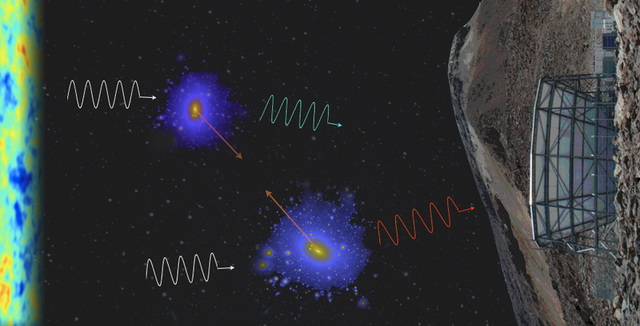
Galaxy clusters are the largest objects in the Universe that are held together by their own gravity. They're so big that the expansion rate and distribution of matter within the Universe affects their formation and evolution. As a result, their numbers, sizes, and motion record the history of the cosmos on its largest scales.
One of the places galaxy clusters leave their imprint is on the Universe's cosmic microwave background (CMB). As the CMB's photons scatter off hot gas in a cluster, its relative motion adds a very slight shift to the photon's wavelength, an effect known as the kinematic Sunyaev-Zel'dovich effect (kSZ). The kSZ effect has now been observed for the first time, as described in a forthcoming paper by Nick Hand et al.
While the distances between clusters grow as the Universe expands, the clusters also move under the influence of other gravitational influences. This "anomalous motion" (as it is called by cosmologists) can indicate attraction between two clusters. That in turn conveys information about the amount of dark matter, dark energy, and suchlike that shapes the expansion of the Universe as a whole. More dark energy would tend to prevent galaxy clusters from falling toward each other, for example, and would show up as a slight repulsive force.
Galaxy clusters have three major components: the galaxies that give them their names, hot gas that surrounds the galaxies, and dark matter. While the dark matter is what binds a cluster together, the kSZ effect is due to the hot gas surrounding the galaxies, known as the intracluster medium.
With temperatures in the range of tens of millions of degrees, the gas is ionized. Photons from the CMB scatter off its free electrons, giving them a slight boost in energy. The amount of energy imparted depends on how fast and in what direction the galaxy cluster is moving, but is independent of how distant the cluster is from observers on Earth. As a result, the kSZ effect conveys information about the cluster's structure and motion, but doesn't require the use of "standard candles" to measure the vast distances in the Universe.
R. A. Sunyaev and Y. B. Zel'dovich first identified their effect in 1972, but couldn't actually detect it—it is very small, so detecting it requires very sensitive astronomical observations. The data in the new study comes from the Atacama Cosmology Telescope (ACT), based in Chile, and the Baryon Oscillation Spectroscopic Survey (BOSS), a project of the Sloan Digital Sky Survey. With over 27,000 available galaxies in the data it contained an abundance of low-mass galaxy clusters, which are very abundant in the BOSS data. ACT is an instrument designed to survey galaxy clusters using the Sunyaev-Zel'dovich effect.
By combining data from the two, Hand et al. were able to detect the kSZ effect unambiguously for the first time, using it to detect the relative motion of galaxy clusters. As Arthur Kosowsky, one of the authors on the study, states, "The (kSZ) calculation is quite simple, once you realize what you need to do and have the necessary data sets in hand."
The researchers found that the galaxy cluster behavior revealed by the kSZ effect is consistent with the consensus cosmological model: a Universe dominated by dark energy and dark matter, with smaller contributions from ordinary (atomic) matter and radiation. Having shown the effect is real and useful, this result opens up a new avenue for observational cosmology. Future higher-precision measurements should be able to test for the presence of small deviations from the established models for gravitation and cosmology, if they exist.
This paper has not yet been through peer review, but the analysis appears sound. (Part of the author's PhD thesis dealt with the Sunyaev-Zel'dovich effect.) It is available on the arXiv. ArXiV:1203.4219
Listing image by Photograph by Sudeep Das (montage) and Adam D. Hincks (photo of ACT)
reader comments
15